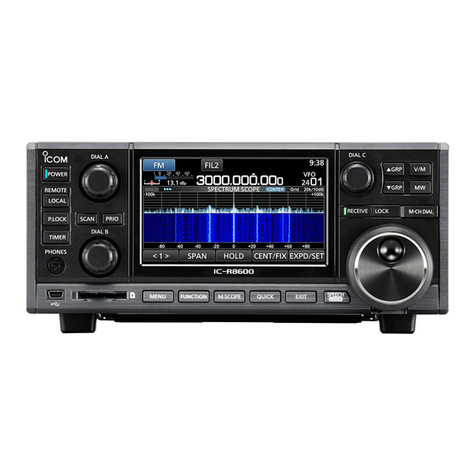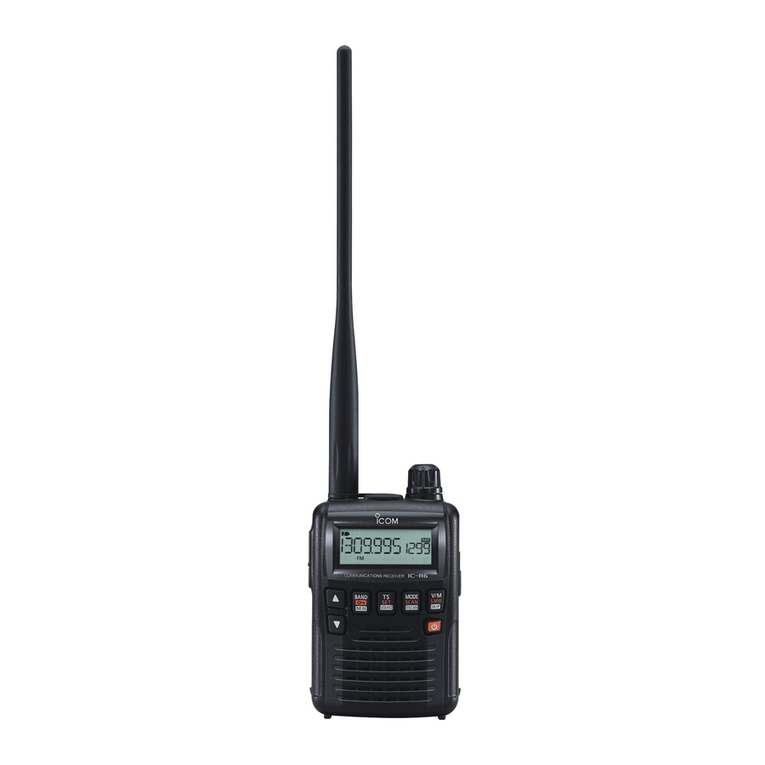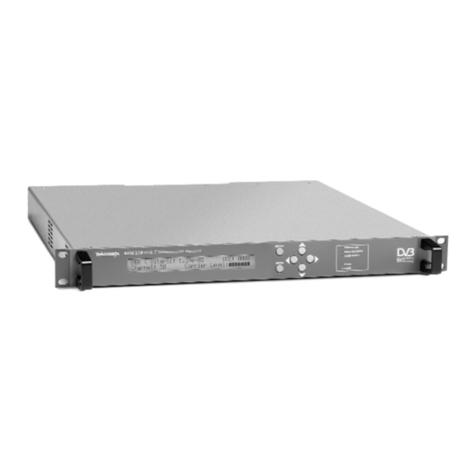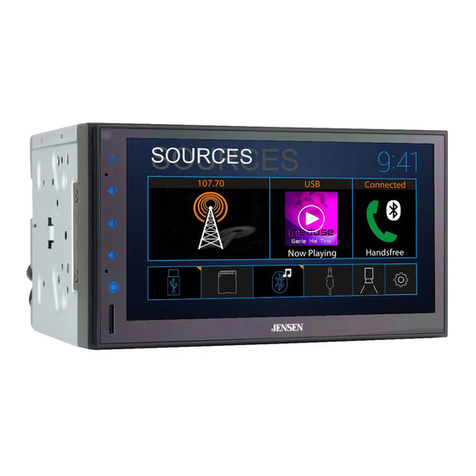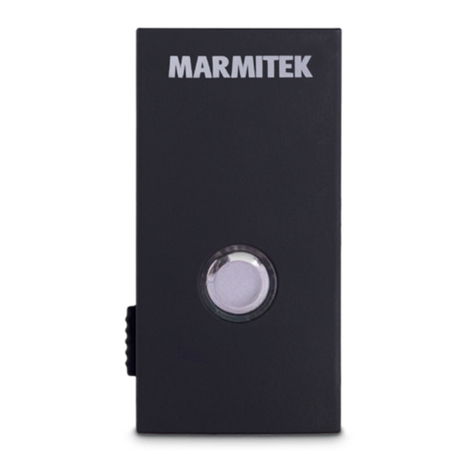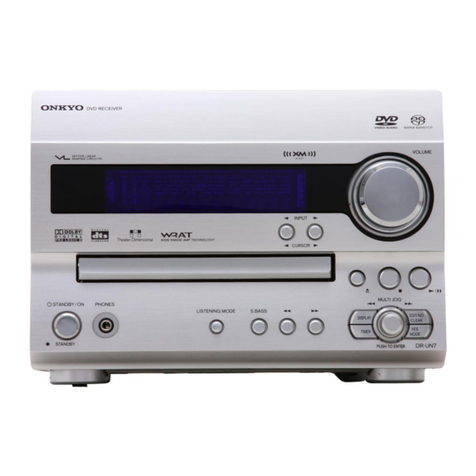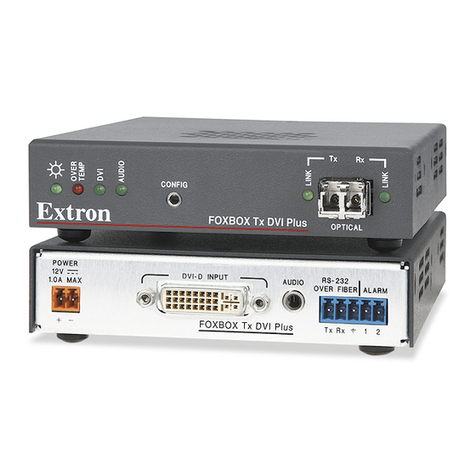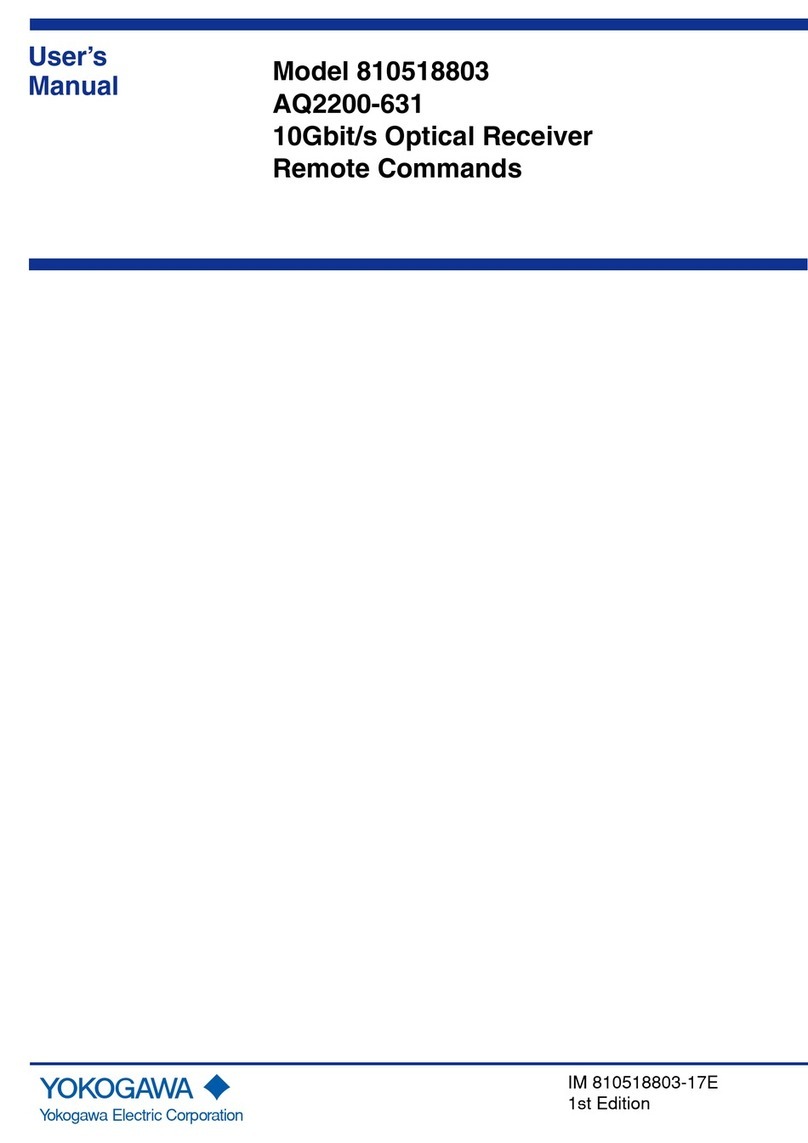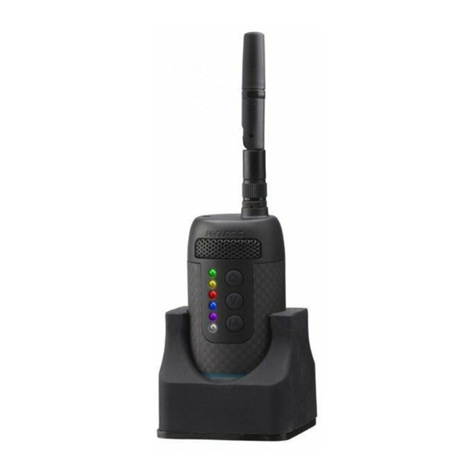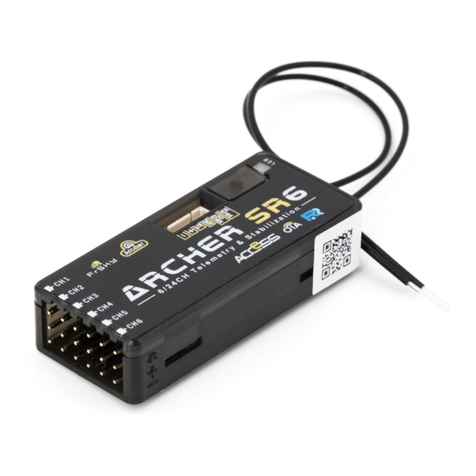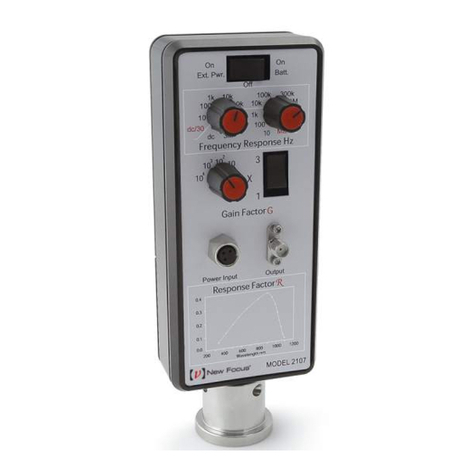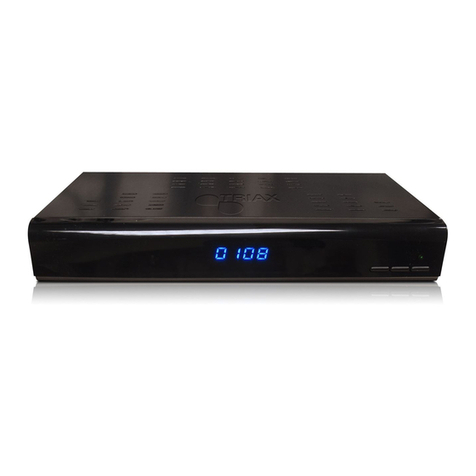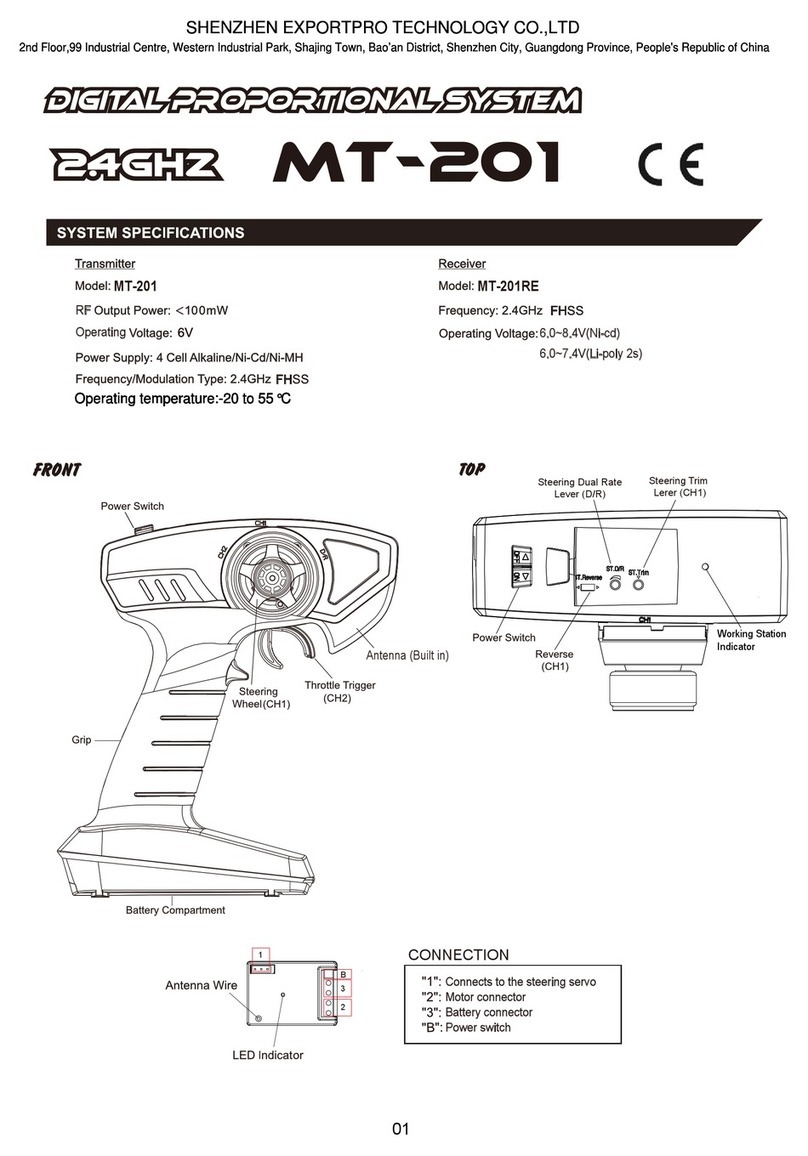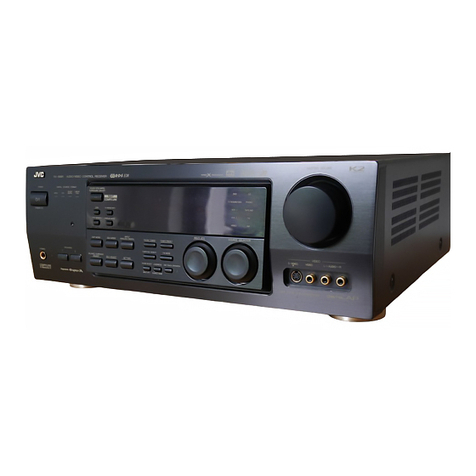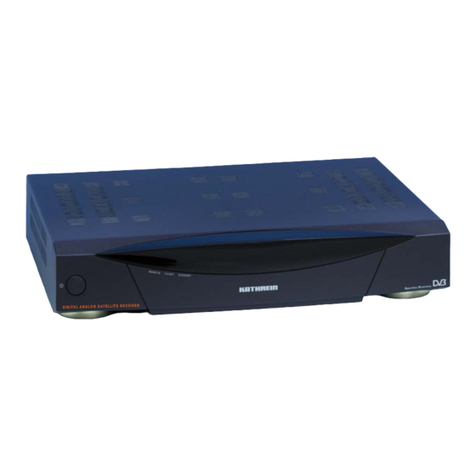Icom IC-R8600 User manual

S-15404XZ-C1
June 2017
SERVICE
MANUAL
COMMUNICATIONS RECEIVER
iR8600

Icom, Icom Inc. and the Icom logo are registered trademarks of Icom Incorporated (Japan) in Japan, the United States, the
United Kingdom, Germany, France, Spain, Russia, Australia, New Zealand, and/or other countries.
This service manual describes the latest technical informa-
tion for the IC-R8600 COMMUNICATIONS RECEIVER at the
time of publication.
To upgrade quality, any electrical or mechanical parts and internal
circuits are subject to change without notice or obligation.
Be sure to include the following four points when ordering
replacement parts:
1. 10-digit Icom part number
2. Component name
3. Equipment model name and unit name
4. Quantity required
<SAMPLE ORDER>
1110003491 S.IC TA31136FNG IC-R8600 MAIN UNIT 5 pieces
8820001210 Screw 2438 screw IC-R8600 Top cover 10 pieces
Addresses for the Icom head office and major authorized dis-
tributorsare provided on the inside back cover for your con-
venience.
ORDERING PARTS
ABOUT THE SDR WIDEBAND RECEIVER CIRCUITS
1. Be sure that the problem is internal before disassembling
the receiver.
2. DO NOT open the receiver until you have disconnected it
from its power source.
3. DO NOT short any circuits or electronic parts.
4. DO NOT keep power ON for a long time when the receiver
is defective.
5. READ the instructions of the test equipment thoroughly
before connecting them to the receiver.
REPAIR NOTES
INTRODUCTION
MODEL VERSION VERSION
NUMBER
IC-R8600
USA #02
EUR #03
USA-01 #04
EXP #05
FRA #06
NEVER connect the receiver to anAC outlet or to a DC power
supply that uses more than the specified voltage. This will
ruin the receiver.
DO NOT expose the receiver to rain, snow or liquids.
DO NOT reverse the polarity of the power cable when con-
necting the receiver.
While ordinary wide band receivers need to have dedicated demodulator circuits for each receive mode, the IC-R8600 utilizes
advanced digital processes that demodulate the incoming signals.
The IF signal is sent to the A/D converter, resulting in digital signal, then is processed by a high-speed FPGA and DSP and then
restored to an analog audio signal.
The received signal is processed to be demodulated according to the receive mode, including not only conventional analog
communications in CW, AM, SSB, FM, WFM, and FSK, but also advanced digital communications in D-STAR, P25, NXDN,
dPMR and DCR. This was archived by using Software Defined Radio (SDR) technology
CAUTION
FPGA
BPF BPF A/D DSP D/A
1st LO 2nd LO
IF Demodulator

TABLE OF CONTENTS
SECTION 1 SPECIFICATIONS
SECTION 2 CONNECTOR INFORMATION
SECTION 3 INSIDE VIEWS
SECTION 4 UPDATING THE FIRMWARE
SECTION 5 ADJUSTMENT PROCEDURES
5-1 PREPARATION ……………………………………………………………………………………… 5-1
5-2 REFERENCE ADJUSTMENT ……………………………………………………………………… 5-3
5-3 HF RECEIVE ADJUSTMENT ……………………………………………………………………… 5-3
5-4 VU RECEIVE ADJUSTMENT ……………………………………………………………………… 5-5
SECTION 6 PARTS LIST
SECTION 7 MECHANICAL PARTS
SECTION 8 REPLACING FUSE
SECTION 9 BOARD LAYOUTS
SECTION 10 WIRING DIAGRAM
SECTION 11 BLOCK DIAGRAM
SECTION 12 VOLTAGE DIAGRAM
DISTRIBUTOR ADDRESS

1-1
SECTION 1 SPECIFICATIONS
MGeneral
• Frequency coverage: [USA] 10.010000 ~ 821.999999 MHz*
851.000000 ~ 866.999999 MHz
896.000000 ~ 3000.000000 MHz
[FRA] 0.135700 ~ 0.137800 MHz
1.810000 ~ 1.850000 MHz
3.500000 ~ 3.800000 MHz
7.000000 ~ 7.200000 MHz
10.100000 ~ 10.150000 MHz
14.000000 ~ 14.350000 MHz
18.068000 ~ 18.168000 MHz
21.000000 ~ 21.450000 MHz
24.890000 ~ 24.990000 MHz
28.000000 ~ 29.700000 MHz
50.000000 ~ 52.000000 MHz
144.000000 ~ 146.000000 MHz
430.000000 ~ 440.000000 MHz
1240.000000 ~1300.000000 MHz
2300.000000 ~2450.000000 MHz
Other versions 0.010000 ~3000.000000 MHz*
*Some frequency ranges are not guaranteed.
• Receiving modes: SSB, CW, FSK, AM, FM, WFM, and
DIGITAL (D-STAR, P25, NXDN, dPMR, and DCR)
• Number of memory channels: 2000 (in 100 groups)
+400 (Scan edges: 100 (50 pairs), Auto Memory Write: 200, and
Scan Skip: 100)
• Scan: Programmed-Scan
Memory-Scan
Selected Mode Memory-Scan
Auto Memory Write-Scan
Selected Memory-Scan
Priority-Scan
• Power supply requirement: 13.8 V DC ±15%
• Power consumption: Standby 1.8 A
Maximum audio 2.0 A
• Grounding system: Negative
• Frequency stability: Less than ±0.5 ppm (at 25ºC)
• Frequency resolution: 1 Hz (minimum)
• Operating temperature range: –10°C to +60°C, +14°F to +140°F
• Dimensions (projections are not included): 220 (W)×90 (H)×230 (D) mm, 8.7 (W)×3.5 (H)×9.1 (D) inches
• Weight (approximately): 4.3 kg, 9.5 Ib
• Antenna connectors:
[ANT1] [ANT2] [ANT3]
Frequency range 10 kHz ~ 3000 MHz 10 kHz ~ 30 MHz 10 kHz ~ 30 MHz
Impedance 50 Unbalanced 50 Unbalanced 500 Unbalanced
Connector Typ e- N SO -23 9 RCA

1-2
MRECEIVER
• Receive system: 0.010000 ~ 29.999999 MHz Direct sampling
30.000000 ~ 1099.999999 MHz Double superheterodyne
1100.000000 ~ 3000.000000 MHz Triple superheterodyne
• Sampling frequency: 122.88 MHz
• Intermediate frequencies:
Receive frequency (MHz) 1st IF (MHz) 2nd IF (MHz) 3rd IF (MHz)
30.000000 ~ 499.999999 778.7 46.35 –
500.000000 ~ 1099.999999 278.7 46.35 –
1100.000000 ~ 1499.999999 900 ~ 500.00001 278.7 46.35
1500.000000 ~ 3000.000000 1000 ~ 500 278.7 46.35
• Sensitivity (P.AMP ON): SSB/CW/FSK (BW: SSB/FSK=2.4 kHz, CW=500 Hz, 10 dB S/N)
0.100000 ~ 1.799999 MHz –6 dB
1.800000 ~ 29.999999 MHz –14 dB
30.000000 ~ 1999.999999 MHz –10 dB
2000.000000 ~ 3000.000000 MHz –8 dB
AM (BW=6 kHz, 10 dB S/N)
0.100000 ~ 1.799999 MHz 16 dB
1.800000 ~ 29.999999 MHz 8 dB
30.000000 ~ 3000.000000 MHz 15 dB
FM (BW=15 kHz, 12 dB SINAD)
28.000000 ~ 1999.999999 MHz –6 dB
2000.000000 ~ 3000.000000 MHz –4 dB
WFM (BW=180 kHz, 12 dB SINAD)
30.000000 ~ 1999.999999 MHz 3 dB
2000.000000 ~ 3000.000000 MHz 5 dB
DIGITAL (D-STAR, NXDN, dPMR, and DCR, 1% BER)
28.000000 ~ 1999.999999 MHz –2 dB
2000.000000 ~ 3000.000000 MHz 0 dB
DIGITAL (P25, 5% BER)
28.000000 ~ 1999.999999 MHz –5 dB
2000.000000 ~ 3000.000000 MHz –3 dB
• Selectivity SSB/FSK
(BW=2.4 kHz)
More than 2.4 kHz/–3 dB
Less than 3.6 kHz/–60 dB
CW (BW=500 Hz) More than 500 Hz/–3 dB
Less than 700 Hz/–60 dB
AM (BW=6 kHz) More than 6.0 kHz/–3 dB
Less than 15.0 kHz/–60 dB
FM (BW=15 kHz) More than 12.0 kHz/–6 dB
Less than 25.0 kHz/–60 dB
WFM More than 180 kHz/–6 dB
• Spurious and image rejection: 0.100000 ~ 29.999999 MHz More than 70 dB
30.000000 ~ 1099.999999 MHz More than 50 dB
1100.000000 ~ 2499.999999 MHz More than 40 dB*
2500.000000 ~ 3000.000000 MHz More than 40 dB*
*In the 1100 MHz and above frequencies, the 1st IF through is more than 35 dB.
*In the 2000 MHz and above frequencies, the 1st IF image rejection is more
than 30 dB.
• Audio output power: More than 2 W (at 10% distortion into an 8 load)
• AF output impedance: 8
All stated specifications are typical and subject to change without notice or obligation.

2-1
SECTION 2 CONNECTOR INFORMATION
[10.7 MHz OUT]
Outputs the 10.7 MHz IF signal for
an external detector/demodulator circuit.
• Center frequency: 10.7 MHz
• Band width*: 10 MHz
• Impedance:50 Ω(unbalanced)
• Maximum output level:–10dBm (approximately)
*The band width is fixed regardless of the digital PBT filter setting.
[REF I/O 10 MHz]
Outputs or inputs a 10 MHz
reference frequency signal.
You can change the signal direction
in the Set mode.
• Center frequency:10 MHz
• Impedance: 50 Ω(unbalanced)
• Input/Output level: –10 dBm (approximately)
• Frequency stability:
±0.5 ppm
(–10°C ~ +60°C, +14°F ~ +140 °F)
[I/Q OUT]
Outputs the Phase/Quadrature data which is
processed by the FPGA.
Connect a PC's USB port, to demodulate the DRM
broadcast or Software Defined Radio SDR.
• Interface: USB (1.1/2.0), Type B
Icom does not provide any support regarding SDR technology and
related software, except the inspection for the normality of output signal.
The IQ driver and instruction guide will be released on the Icom
website near future.
http://www.icom.co.jp/world/index.html
[AF/IF]
Outputs the demodulate audio signal or 12 kHz IF
signal (unfiltered). The output level is fixed, regardless
of the volume control position. (3.5 mm, ⅛in (d))
• Impedance: 4.7 kΩ
• Output level: 100 ~ 300 mV (RMS)
You can select the output signal from AF or IF signals.
MENU » SET > Connectors > AF/IF
The signal is also output from [USB] (front or rear) or [LAN].
[USB]
2 USB ports: Type B mini and Type B.
You can download the USB driver and installation
guide from the Icom website.
http://www.icom.co.jp/world/support/download/firm
•Outputs the decoded FSK (RTTY) signal, or D-STAR data.
•Outputs the demodulated signal or 12 kHz IF signal.
• Remote control interface for optional RS-R8600 (feature product).
• Programming interface for the optional CS-R8600.
You can change the port settings (FSK decode data/D-STAR data,
AF/IF), baud rate and output level)
MENU » SET > Connectors > USB (Front)
MENU » SET > Connectors > USB (Rear)
[LAN]
LED indication:
q
LINK/ACT Lights: Cable connected.
Doesn't light: Cable not connected.
Blinks: While the line is communicating.
w
Speed Lights: Communicating in 100BASE-TX
Doesn't lights:
Communicating in
10BASE-T,
or not connected.
•Time synchronization by an NTP server.
• Outputs the demodulated signal or 12 kHz IF signal.
•Remote control interface for the optional RS-R8600 (future
product).
You can select the output signal from AF and IF signals.
MENU » SET > Connectors > LAN
[MUTE] JACK / [MUTE] SWITCH
Used to mute the receiver
output.
(3.5 mm, ⅛in (d))
When the Mute Switch is slid to right, the receiver
enters to the Bit Error Rate (BER) Measurement mode
for the maintenance purpose.
When the [MUTE] is slid to left:
When this terminal is grounded, the receive circuit is turned OFF.
Use this function when you use the IC-R8600 with a transceiver.
The sink current is approximately 1 mA at 8 V input.
When the [MUTE] is slid to right:
Connect a BER counter. In the BER Measurement mode,
the PN9 bit stream is output from this terminal.
[METER]
Connects to an external meter.
Outputs the received signal
strength or squelch level.
(3.5 mm, ⅛in (d))
• Output voltage: 8 V (maximum)
• Output impedance: 10 kΩ
You can select the output signal from received signal strength
and squelch levels.
MENU » SET > Connectors
qw
+_
BNC type
BNC type
On the front panel
miniB type B type
On the rear panel
Meter output

2-2
[REMOTE]
Used to remotely controls the receiver with
the CI-V format data.
(3.5 mm, ⅛in (d))
You can download the USB driver and installation
guide from the Icom website.
http://www.icom.co.jp/world/support/download/firm
In the remote control mode, push [LOCAL] to return to the normal
(Local) mode (LOCAL LED turns OFF).
*Except , and .
[EXT-SP]
Connects to an external speaker such as
the optional SP-39AD.
(3.5 mm, ⅛in (d))
• Output impedance: 4 ~ 8 Ω
• Output level: More than 2 W at 10% distortion into an 8 Ω
load.
[DC IN]
Connects to the optional
SP-39AD.
When the SP-39AD or AD-55NS is connected,
connect the supplied DC short connector to [DC13.8V].
[DC13.8V]
Accepts the regulated DC power for
13.8 V DC (±15%), through the
supplied DC power cable.
WARNING! NEVER reverse the DC power cable
polarity (Red= , Black= ).
[ANT 1] • Frequency range: 10 kHz ~ 3000 MHz
• Input impedance: 50 Ω(unbalanced)
When the receive frequency is set to between 10 kHz and
29.999999 MHz, you can select the antenna on [ANT 1] ~ [ANT 3].
[ANT 2] • Frequency range: 10 kHz ~ 30 MHz
• Input impedance: 50 Ω(unbalanced)
[ANT 3]
For a long wire antenna.
• Frequency range: 10 kHz ~ 30 MHz
• Input impedance: 400 ~ 500 Ω(unbalanced)
[AUX]
A reserved terminal. No internal connection.
[PHONES]
Connects to standard stereo headphones.
(3.5 mm, ⅛in (d))
• Output impedance: 8 ~ 16 Ω
• Output level: More than 50 mW (into an 8 Ωload)
SO-239
View from the rear
Type-N
RCA type
RCA type

3-1
SECTION 3 INSIDE VIEWS
???????
(???)
BPF UNIT
• RF UNIT
• MAIN UNIT
???????
(???)
J2 [DCIN]
J6 [METER]
J4 [SPARE]
J4 [ANT3]
J2 [ANT2]
J1 [ANT1]
J1401 [LAN]
J392 [MUTE]
J321 [USB]
J371 [REMOTE]
J261 [AF/IF]
J241 [EXP-SP]
J1451 [I/Q OUT]
J3 [REF I/O]
J1451
J242
J810J901
J3
J290
J541
J2022
J531
J41
J71
J11
J812
J501
J751
J591
J571
J801
J1102
J201
J1
J322
???????
(???)
J813
???????
(???)

3-2
• FRONT UNIT
DIM CTRL
(Q43)
DIM CTRL
(Q41)
TW-CTRL
(IC52)
D/A CONVERTER
(IC102)
BUFF
(IC103)
FRONT CPU
(IC101)

3-3
• MAIN UNIT
BUFF
(IC271)
A/D CONVERTER
(IC581)
FPGA
(IC801)
AF AMP
(IC791)
D/A CONVERTER
(IC703)
CPU
(IC1301) FLASH ROM
(IC1352)
+3.3 V REGURATOR
(IC153)
LAN DRIVER
(IC1401)
DV-DSP
(IC1002)
FLASH ROM
(IC1003)
PULSE TRANSFORMER
(T1401)
USB 2.0 I/F
(IC1451)
D/A CONVERTER
(IC701)
USB BRIDGE
(IC2051)
STEP ATT
(IC543)
USB HUB
(IC2021)
LVDS BUFF
(IC511)
SRAM
(IC802)
AMP FOR HEADPHONE
(IC203)
USB BRIDGE
(IC351)
USB BRIDGE
(IC341)
SRAM
(IC1051)
OVER-VOLTAGE PROTECT
(IC51)
SDRAM
(IC1281)
UB HUB
(IC321)
USB
CODEC
(IC302)
USB
CODEC
(IC2002)
• RF UNIT
+5 V REGULATOR
(IC1803)
PRE AMP
(IC1511)
PLL/VCO FOR CONV LO
(IC1201)
LO AMP
(IC1261)
RF AMP
(IC1051)
PLL/VCO
FOR VU2 LO
(IC701)
+9 V REGULATOR
(IC901)
PLL/VCO
(IC1701)
IF AMP
(Q581)
LO AMP
(Q641)
RF AMP
(IC1151)
+5 V REGULATOR
(IC1203)
+5 V REGULATOR
(IC1832)
+5 V REGULATOR
(IC1651)
+5 V REGULATOR
(IC1752)
RF AMP
(IC1521)
PRE AMP
(Q301)

4-1
SECTION 4 UPDATING THE FIRMWARE
General Preparation
DAbout updating the firmware
You can update the IC-R8600’s firmware using an SD
card. Updating the firmware may add new functions
and improves performance parameters.
You can download the latest firmware from the Icom
website.
http://www.icom.co.jp/world/index.html
DChecking the firmware version
You can check the firmware version on the Opening
screen when you turn ON the receiver.
TIP: You can also check the firmware version on the
INFORMATION screen.
MENU » SET > Others > Information > Version
The Main CPU's firmware version is displayed.
DDownloading the firmware file
Access the following URL and download the firmware file.
http://www.icom.co.jp/world/index.html
These instructions are based on Microsoft®Windows®7.
1. Click [Support].
2. Click “Firmware Updates/Software Downloads”.
3. Click the desired firmware file link.
4. Read “Regarding this Download Service” carefully,
and then click [Agree].
5.
Click “Save as” in the displayed File Download dialog.
6. Select the location where you want to save the
firmware, and then click [Save] in the displayed File
Download dialog.
• The file starts downloading.
•
The firmware and the firm utility are compressed in a “zip”
format folder. Unzip it before use.
DUnzipping the firmware folder
1. Right-click the downloaded firmware file
(zip format).
• Right-click menu is displayed.
2. Click “Extract All...”
•After unzipping, a folder is created in the same location
as the downloaded file.
In the “R8600_X*” folder, “8600XXXX.dat*” is created.
* X represents the release number.

4-2
Updating the firmware
IMPORTANT:
To update the firmware, first format
your SD card using the IC-R8600. (See the Instruction
manual p. 7-2 for details.) Then copy the downloaded
firmware data from your PC into the IC-R8600 folder
that was created on the SD card.
CAUTION:
NEVER turn OFF the receiver while
updating the firmware.
If you turn OFF the receiver, or if a power failure
occurs while updating, the firmware will be damaged
and you will have to send the receiver back to the
nearest Icom distributor for repair. This type of repair
is out of warranty, even if the receiver warranty period
is still valid.
TIP: BE SURE to unzip the downloaded file. See
“Unzipping the firmware folder (p. 4-1)” for details.
1.
Copy the downloaded firmware data into the
IC-R8600 folder on the SD card.
2. Insert the SD card into the receiver's
[SD CARD] slot.
3. On the Set mode menu screen, display the
SD CARD screen.
MENU » SET > SD card
4. Select “Firmware Update.”
The Firmware Update Agreement screen
TIP:
To check the firmware version after the updating,
see the Instruction manual “Checking the firmware
version (p. 13-1)” for details.
5. Touch [Ù] or [Ú] to scroll the screen.
Carefully read all the displayed precautions.
6. After you read and agree with all the precautions,
touch [YES].
• The file select screen is displayed.
If you want to cancel the updating, touch [NO].
7. Touch the Firmware (Example: 8600XXXX.dat*).
• The final confirmation screen is displayed.
Carefully read all the displayed precautions.
* X represents the release number.
8. After you read and agree with all the precautions,
touch [YES] for 1 second.
• The updating starts.
If you want to cancel the updating, touch [NO].
9. “Firmware updating has completed.” is displayed
in the dialog.
• The IC-R8600 will automatically restart.
After the updating finishes, the operating screen is
displayed.
Copy

5-1
SECTION 5 ADJUSTMENT PROCEDURE
5-1 PREPARATION
■REQUIRED EQUIPMENT
EQUIPMENT GRADE AND RANGE EQUIPMENT GRADE AND RANGE
DC power supply Output voltage: 13.8 V DC
Current capacity: At least 2 A Standard signal
generator (SSG)
Frequency range: 0.1~3000 MHz
Output level: 0.1 μV to 32 mV
(−127~−17 dBm)
Output impedance
: 50 Ω
Short plug Modified 3.5 mm (⅛˝) monaural plug
(See the illustration below)
■ENTERING THE ADJUSTMENT MODE
1. Connect the JIG cable (see the illustration below) to the
[REMOTE] jack.
Short circuited
[JIG cable]
3-conductor 3.5(d) mm plug
2. While holding down both [MENU] and [FUNCTION], turn
the power ON.
[FUNCTION][MENU]
[POWER]
3. The adjustment main menu is displayed as below.
14.150.00000
ANT1
ANT1
VFO
VFO
12:00
12:00
USB
USB
FIL2
FIL2
AGC-F
AGC-F
S
(
(
/'
/'
W'
W'
C
C
&522$(
&522$(
&52&
&52&
(2)#
(2)#
&8&52
&8&52
13579
+20 +40 +60dB
FRONT
FRONT
PRESET
PRESET
REF
REF
HF-RX
HF-RX
VU-RX
VU-RX
TS
TS
00
00
20k
20k
ADJUST MODE
ADJUST MODE
Z
■CONNECTIONS
Standard signal
generator (SSG)
0.1~3000 MHz
0.1μV to 32 mV
DC Power supply
- 13.8 V DC/≥3 A
- AD-55NS
- SP-39AD
The tests described in this section should be measured and adjusted with the above test equipment.
However, a radio tester can also be used for these adjustment procedures.

5-2
■ADJUSTMENT MENU DESCRIPTION
· MAIN MENU
14.150.00000
ANT1
ANT1
VFO
VFO
12:00
12:00
USB
USB
FIL2
FIL2
AGC-F
AGC-F
S
(
(
/'
/'
W'
W'
C
C
&522$(
&522$(
&52&
&52&
(2)#
(2)#
&8&52
&8&52
13579
+20 +40 +60dB
FRONT
FRONT
PRESET
PRESET
REF
REF
HF-RX
HF-RX
VU-RX
VU-RX
TS
TS
00
00
20k
20k
ADJUST MODE
ADJUST MODE
Z
Entering into the Reference adjustment menu
Entering into the HF receive adjustment menu
Entering into the VHF/UHF receive adjustment menu
· REFERENCE ADJUSTMENT MENU
14.150.00000
ANT1
ANT1
VFO
VFO
12:00
12:00
USB
USB
FIL2
FIL2
AGC-F
AGC-F
S
4'(
4'(
&522$(
&522$(
&52&
&52&
(2)#
(2)#
&8&52
&8&52
13579
+20 +40 +60dB
REF
REF
ULKck
ULKck
REF
REF
HF-RX
HF-RX
VU-RX
VU-RX
TS
TS
00
00
20k
20k
ADJUST MODE
ADJUST MODE
Z
Starts the PLL unlock adjustment
Starts the reference frequency adjustment
· HF RECEIVE ADJUSTMENT MENU
14.150.00000
ANT1
ANT1
VFO
VFO
12:00
12:00
USB
USB
FIL2
FIL2
AGC-F
AGC-F
S
*(
*(
&522$(
&522$(
&52&
&52&
(2)#
(2)#
&8&52
&8&52
13579
+20 +40 +60dB
HF-G
HF-G
HF-S
HF-S
HF-flat
HF-flat
HF-RX
HF-RX
VU-RX
VU-RX
TS
TS
00
00
20k
20k
ADJUST MODE
ADJUST MODE
Z
Starts the HF S-meter adjustment
Starts the HF-flat adjustment
Starts the HF total gain adjustment
· VHF/UHF RECEIVE ADJUSTMENT MENU
14.150.00000
ANT1
ANT1
VFO
VFO
12:00
12:00
USB
USB
FIL2
FIL2
AGC-F
AGC-F
S
87
87
&522$(
&522$(
&52&
&52&
(2)#
(2)#
&8&52
&8&52
13579
+20 +40 +60dB
VU1
VU1
VU2
VU2
VU12-flat
VU12-flat
VU3
VU3
VU4
VU4
TS
TS
00
00
20k
20k
ADJUST MODE
ADJUST MODE
Z
Starts the VU2 total gain adjustment
Starts the VU12-flat adjustment
Starts the VU1 total gain adjustment
Starts the VU3 total gain adjustment
Starts the VU4 total gain adjustment
· ADJUSTMENT ITEM
*()
*()
*(6QVCN)CKP24'1((TGH
*(6QVCN)CKP24'1((TGH
$
$
Y Z
HF-flat
HF-flat
HF-RX
HF-RX
SET
SET
ADJUST MODE
ADJUST MODE
Selects the next adjustment item
Adjustment item nameAdjusted value
Starts the adjustment
Selects the previous adjustment item

5-3
5-2 REFERENCE ADJUSTMENT
• Touch [REF] on the main menu screen.
NOTE: DO NOT change the test equipment output level until the second beeps sound.
ADJUSTMENT ADJUSTMENT ITEM DISPLAY CONDITION OPERATION
PREPARATION 1 – – Touch [REF] to start
the reference frequency
adjustment.
REFERENCE
FREQUENCY 2 REF OSC • Connect the test equipment to the
[ANT1], and set as shown below:
Frequency: 250.0 MHz
Modulation: None
Level: +40 dBμ†(–67 dBm)
Touch [SET].
(A beep sounds, and then
another beeps sound
after the adjustment is
completed.)
PLL UNLOCK 3REFULKck
4PULK0ck
5PULK1ck
6PULK2ck
• After the adjustment, the receiver shows the reference adjustment menu.
• Push [EXIT] to return to the main menu screen.
5-3 HF RECEIVE ADJUSTMENT
• Touch [HF-RX] on the main menu screen.
NOTE: DO NOT change the test equipment output level until the second beeps sound.
ADJUSTMENT ADJUSTMENT ITEM DISPLAY CONDITION OPERATION
PREPARATION 1 – – Touch [HF-G] to start the
HF total gain adjustment.
HF TOTAL GAIN
(Preamp OFF) 2 HF Total Gain PRE OFF ref • Connect the test equipment to the
[ANT1], and set as shown below:
Frequency: 14.1515 MHz
Modulation: None
Level: +60 dBμ†(–47 dBm)
Touch [SET].
(A beep sounds, and then
another beeps sound
after the adjustment is
completed.)
3 HF Total Gain PRE OFF set • Set the test equipment level to:
Level: OFF
Touch [SET].
(A beep sounds, and then
another beeps sound 10
seconds later.)
HF TOTAL GAIN
(Preamp ON) 4 HF Total Gain PRE ON ref • Set the test equipment level to:
Level: +60 dBμ†(–47 dBm)
Touch [SET].
(A beep sounds, and then
another beeps sound
after the adjustment is
completed.)
5 HF Total Gain PRE ON set • Set the test equipment level to:
Level: OFF
Touch [SET].
(A beep sounds, and then
another beeps sound 10
seconds later.)
HF S-METER 6 HF S0 LEVEL • Set the test equipment level to:
Level: +4 dBμ†(–103 dBm)
Touch [SET].
(A beep sounds, and then
another beeps sound 1
second later.)
7 HF S9 LEVEL • Set the test equipment level to:
Level: +34 dBμ†(–73 dBm)
8 HF S9+60 LEVEL • Set the test equipment level to:
Level: +94 dBμ†(–13 dBm)
9 HF dBu –10dBu • Set the test equipment level to:
Level: –10 dBμ†(–117 dBm)
10 HF dBu 0dBu • Set the test equipment level to:
Level: 0 dBμ†(–107 dBm)
11 HF dBu 10dBu • Set the test equipment level to:
Level: +10 dBμ†(–97 dBm)
12 HF dBu 20dB • Set the test equipment level to:
Level: +20 dBμ†(–87 dBm)
13 HF dBu 40dBu • Set the test equipment level to:
Level: +40 dBμ†(–67 dBm)
14 HF dBu 60dBu • Set the test equipment level to:
Level: +60 dBμ†(–47 dBm)
15 HF dBu 80dBu • Set the test equipment level to:
Level: +80 dBμ†(–27 dBm)
†: The output level of the standard signal generator (SSG) is indicated as the SSG’s open circuit.

5-4
ADJUSTMENT ADJUSTMENT ITEM DISPLAY CONDITION OPERATION
HF-flat 16 HF BPF0 flat • Set the test equipment to:
Frequency: 0.2515 MHz
Modulation: None
Level: +40 dBμ†(–67 dBm)
Touch [SET].
(A beep sounds, and then
another beeps sound 1
second later.)
17 HF BPF1 flat • Set the test equipment to:
Frequency: 1.1015 MHz
18 HF BPF2 flat • Set the test equipment to:
Frequency: 1.8215 MHz
19 HF BPF3 flat • Set the test equipment to:
Frequency: 2.6015 MHz
20 HF BPF4 flat • Set the test equipment to:
Frequency: 3.6015 MHz
21 HF BPF5 flat • Set the test equipment to:
Frequency: 5.1015 MHz
22 HF BPF6 flat • Set the test equipment to:
Frequency: 7.0815 MHz
23 HF BPF7 flat • Set the test equipment to:
Frequency: 10.1015 MHz
24 HF BPF9 flat • Set the test equipment to:
Frequency: 18.1515 MHz
25 HF BPF10 flat • Set the test equipment to:
Frequency: 28.1015 MHz
26 HF BPF11 flat (L) Set the test equipment to:
Frequency: 0.5015 MHz
27 HF BPF11 flat ( M) • Set the test equipment to:
Frequency: 14.1515 MHz
28 HF BPF11 flat (H) • Set the test equipment to:
Frequency: 29.9015 MHz
HF-flat
(Preamp ON) 29 HF PRE flat (L) • Set the test equipment to:
Frequency: 0.5015 MHz
30 HF PRE flat ( M) • Set the test equipment to:
Frequency: 14.1515 MHz
31 HF PRE flat (H) • Set the test equipment to:
Frequency: 29.9015 MHz
HF-flat
(ATT) 32 HF ATT 10dB flat • Set the test equipment to:
Frequency: 14.1515 MHz
Modulation: None
Level: +40 dBμ†(–67 dBm)
33 HF ATT 20dB flat
• After the adjustment, the receiver shows the HF receive adjustment menu.
• Push [EXIT] to return to the main menu screen.
5-3 HF RECEIVE ADJUSTMENT (CONTINUED)
†: The output level of the standard signal generator (SSG) is indicated as the SSG’s open circuit.

5-5
5-4 VU RECEIVE ADJUSTMENT
• Touch [VU-RX] on the main menu screen.
NOTE: DO NOT change the test equipment output level until the second beeps sound.
ADJUSTMENT ADJUSTMENT ITEM DISPLAY CONDITION OPERATION
PREPARATION 1 – – Touch [VU1] to start
the VU-1 total gain
adjustment.
VU1 TOTAL GAIN
(Preamp OFF) 2 VU1 Total Gain PRE OFF ref • Connect the test equipment to the
[ANT1], and set as shown below:
Frequency: 50.1515 MHz
Modulation: None
Level: +60 dBμ†(–47 dBm)
Touch [SET].
(A beep sounds, and then
another beeps sound
after the adjustment is
completed.)
3 VU1 Total Gain PRE OFF set • Set the test equipment level to:
Level: OFF
Touch [SET].
(A beep sounds, and then
another beeps sound 10
seconds later.)
VU1 TOTAL GAIN
(Preamp ON) 4 VU1 Total Gain PRE ON ref • Set the test equipment level to:
Level: +60 dBμ†(–47 dBm)
Touch [SET].
(A beep sounds, and then
another beeps sound
after the adjustment is
completed.)
5 VU1 Total Gain PRE ON set • Set the test equipment level to:
Level: OFF
Touch [SET].
(A beep sounds, and then
another beeps sound 10
seconds later.)
VU1 S-METER 6 VU1 S0 LEVEL • Set the test equipment level to:
Frequency: 50.1515 MHz
Modulation: None
Level: 0 dBμ†(–107 dBm)
Touch [SET].
(A beep sounds, and then
another beeps sound 1
second later.)
7 VU1 S9 LEVEL • Set the test equipment level to:
Level: +34 dBμ†(–73 dBm)
8 VU1 S9+60 LEVEL • Set the test equipment level to:
Level: +94 dBμ†(–13 dBm)
9 VU1 dBu –10dB • Set the test equipment level to:
Level: –10 dBμ†(–117 dBm)
10 VU1 dBu 0dB • Set the test equipment level to:
Level: 0 dBμ†(–107 dBm)
11 VU1 dBu 10dB • Set the test equipment level to:
Level: +10 dBμ†(–97 dBm)
12 VU1 dBu 20dB • Set the test equipment level to:
Level: +20 dBμ†(–87 dBm)
13 VU1 dBu 40dB • Set the test equipment level to:
Level: +40 dBμ†(–67 dBm)
14 VU1 dBu 60dB • Set the test equipment level to:
Level: +60 dBμ†(–47 dBm)
15 VU1 dBu 80dB • Set the test equipment level to:
Level: +80 dBμ†(–27 dBm)
VU2 TOTAL GAIN
(Preamp OFF) 16 VU2 Total Gain PRE OFF ref • Set the test equipment to:
Frequency: 625.0215 MHz
Modulation: None
Level: +60 dBμ†(–47 dBm)
Touch [SET].
(A beep sounds, and then
another beeps sound
after the adjustment is
completed.)
17 VU2 Total Gain PRE OFF set • Set the test equipment level to:
Level: OFF
Touch [SET].
(A beep sounds, and then
another beeps sound 10
seconds later.)
VU2 TOTAL GAIN
(Preamp ON) 18 VU2 Total Gain PRE ON ref • Set the test equipment level to:
Level: +60 dBμ†(–47 dBm)
Touch [SET].
(A beep sounds, and then
another beeps sound
after the adjustment is
completed.)
19 VU2 Total Gain PRE ON set • Set the test equipment level to:
Level: OFF
Touch [SET].
(A beep sounds, and then
another beeps sound 10
seconds later.)
†: The output level of the standard signal generator (SSG) is indicated as the SSG’s open circuit.

5-6
ADJUSTMENT ADJUSTMENT ITEM DISPLAY CONDITION OPERATION
VU2 S-METER 20 VU2 S0 LEVEL • Set the test equipment to:
Frequency: 625.0215 MHz
Modulation: None
Level: 0 dBμ†(–107 dBm)
Touch [SET].
(A beep sounds, and then
another beeps sound 1
seconds later.)
21 VU2 S9 LEVEL • Set the test equipment level to:
Level: +34 dBμ†(–73 dBm)
22 VU2 S9+60 LEVEL • Set the test equipment level to:
Level: +94 dBμ†(–13 dBm)
23 VU2 dBu –10dB • Set the test equipment level to:
Level: –10 dBμ†(–117 dBm)
24 VU2 dBu 0dB • Set the test equipment level to:
Level: 0 dBμ†(–107 dBm)
25 VU2 dBu 10dB • Set the test equipment level to:
Level: 10 dBμ†(–97 dBm)
26 VU2 dBu 20dB • Set the test equipment level to:
Level: 20 dBμ†(–87 dBm)
27 VU2 dBu 40dB • Set the test equipment level to:
Level: 40 dBμ†(–67 dBm)
28 VU2 dBu 60dB • Set the test equipment level to:
Level: 60 dBμ†(–47 dBm)
29 VU2 dBu 80dB • Set the test equipment level to:
Level: 80 dBμ†(–27 dBm)
VU12-flat 30 VU12 BPF1 flat ( M) • Set the test equipment to:
Frequency: 40.0215 MHz
Modulation: None
Level: +40 dBμ†(–67 dBm)
31 VU12 BPF1 flat (L) • Set the test equipment to:
Frequency: 30.0215 MHz
32 VU12 BPF1 flat (H) • Set the test equipment to:
Frequency: 49.9815 MHz
33 VU12 BPF2 flat ( M) • Set the test equipment to:
Frequency: 65.0215 MHz
34 VU12 BPF2 flat (H) • Set the test equipment to:
Frequency: 79.9815 MHz
35 VU12 BPF3 flat ( M) • Set the test equipment to:
Frequency: 105.0215 MHz
36 VU12 BPF3 flat (L) • Set the test equipment to:
Frequency: 80.0215 MHz
37 VU12 BPF3 flat (H) • Set the test equipment to:
Frequency: 129.9815 MHz
38 VU12 BPF4 flat ( M) • Set the test equipment to:
Frequency: 165.0215 MHz
39 VU12 BPF4 flat (L) • Set the test equipment to:
Frequency: 130.0215 MHz
40 VU12 BPF4 flat (H) • Set the test equipment to:
Frequency: 199.9815 MHz
41 VU12 BPF5 flat ( M) • Set the test equipment to:
Frequency: 260.0215 MHz
42 VU12 BPF5 flat (L) • Set the test equipment to:
Frequency: 200.0215 MHz
43 VU12 BPF5 flat (H) • Set the test equipment to:
Frequency: 319.9815 MHz
44 VU12 BPF6 flat ( M) • Set the test equipment to:
Frequency: 410.0215 MHz
45 VU12 BPF6 flat (L) • Set the test equipment to:
Frequency: 320.0215 MHz
46 VU12 BPF6 flat (H) • Set the test equipment to:
Frequency: 499.9815 MHz
47 VU12 BPF7 flat (L) • Set the test equipment to:
Frequency: 500.0215 MHz
48 VU12 BPF7 flat (M1) • Set the test equipment to:
Frequency: 580.0215 MHz
49 VU12 BPF7 flat (M2) • Set the test equipment to:
Frequency: 670.0215 MHz
50 VU12 BPF7 flat (H) • Set the test equipment to:
Frequency: 749.9815 MHz
5-4 VU RECEIVE ADJUSTMENT (CONTINUED)
†: The output level of the standard signal generator (SSG) is indicated as the SSG’s open circuit.

5-7
ADJUSTMENT ADJUSTMENT ITEM DISPLAY CONDITION OPERATION
VU12-flat
(continued) 51 VU12 BPF8 flat ( M) • Set the test equipment to:
Frequency: 925.0215 MHz
Touch [SET].
(A beep sounds, and then
another beeps sound 1
seconds later.)
52 VU12 BPF8 flat (L) • Set the test equipment to:
Frequency: 750.0215 MHz
53 VU12 BPF8 flat (M1) • Set the test equipment to:
Frequency: 850.0215 MHz
54 VU12 BPF8 flat (M2) • Set the test equipment to:
Frequency: 1020.0215 MHz
55 VU12 BPF8 flat (H) • Set the test equipment to:
Frequency: 1099.9815 MHz
VU12-flat
(Preamp ON) 56 VU12 PRE flat (40 M) • Set the test equipment to:
Frequency: 40.0215 MHz
57 VU12 PRE flat (65 M) • Set the test equipment to:
Frequency: 65.0215 MHz
58 VU12 PRE flat (105 M) • Set the test equipment to:
Frequency: 105.0215 MHz
59 VU12 PRE flat (165 M) • Set the test equipment to:
Frequency: 165.0215 MHz
60 VU12 PRE flat (260 M) • Set the test equipment to:
Frequency: 260.0215 MHz
61 VU12 PRE flat (410 M) • Set the test equipment to:
Frequency: 410.0215 MHz
62 VU12 PRE flat (500 M) • Set the test equipment to:
Frequency: 500.0215 MHz
63 VU12 PRE flat (625 M) • Set the test equipment to:
Frequency: 625.0215 MHz
64 VU12 PRE flat (749 M) • Set the test equipment to:
Frequency: 749.9815 MHz
65 VU12 PRE flat (750 M) • Set the test equipment to:
Frequency: 750.0215 MHz
66 VU12 PRE flat (925 M) • Set the test equipment to:
Frequency: 925.0215 MHz
67 VU12 PRE flat (1099 M) • Set the test equipment to:
Frequency: 1099.9815 MHz
VU12-flat
(ATT 10dB) 68 VU12 ATT 10dB flat (40 M) • Set the test equipment to:
Frequency: 40.0215 MHz
69 VU12 ATT 10dB flat (65 M) • Set the test equipment to:
Frequency: 65.0215 MHz
70 VU12 ATT 10dB flat (105 M) • Set the test equipment to:
Frequency: 105.0215 MHz
71 VU12 ATT 10dB flat (165 M) • Set the test equipment to:
Frequency: 165.0215 MHz
72 VU12 ATT 10dB flat (260 M) • Set the test equipment to:
Frequency: 260.0215 MHz
73 VU12 ATT 10dB flat (410 M) • Set the test equipment to:
Frequency: 410.0215 MHz
74 VU12 ATT 10dB flat (625 M) • Set the test equipment to:
Frequency: 625.0215 MHz
75 VU12 ATT 10dB flat (925 M) • Set the test equipment to:
Frequency: 925.0215 MHz
VU12-flat
(ATT 20dB) 76 VU12 ATT 20dB flat (40 M) • Set the test equipment to:
Frequency: 40.0215 MHz
77 VU12 ATT 20dB flat (65 M) • Set the test equipment to:
Frequency: 65.0215 MHz
78 VU12 ATT 20dB flat (105 M) • Set the test equipment to:
Frequency: 105.0215 MHz
79 VU12 ATT 20dB flat (165 M) • Set the test equipment to:
Frequency: 165.0215 MHz
80 VU12 ATT 20dB flat (260 M) • Set the test equipment to:
Frequency: 260.0215 MHz
81 VU12 ATT 20dB flat (410 M) • Set the test equipment to:
Frequency: 410.0215 MHz
82 VU12 ATT 20dB flat (625 M) • Set the test equipment to:
Frequency: 625.0215 MHz
83 VU12 ATT 20dB flat (925 M) • Set the test equipment to:
Frequency: 925.0215 MHz
5-4 VU RECEIVE ADJUSTMENT (CONTINUED)
†: The output level of the standard signal generator (SSG) is indicated as the SSG’s open circuit.

5-8
ADJUSTMENT ADJUSTMENT ITEM DISPLAY CONDITION OPERATION
VU12-flat
(ATT 30dB) 84 VU12 ATT 30dB flat (40 M) • Set the test equipment to:
Frequency: 40.0215 MHz
Touch [SET].
(A beep sounds, and then
another beeps sound 1
seconds later.)
85 VU12 ATT 30dB flat (65 M) • Set the test equipment to:
Frequency: 65.0215 MHz
86 VU12 ATT 30dB flat (105 M) • Set the test equipment to:
Frequency: 105.0215 MHz
87 VU12 ATT 30dB flat (165 M) • Set the test equipment to:
Frequency: 165.0215 MHz
88 VU12 ATT 30dB flat (260 M) • Set the test equipment to:
Frequency: 260.0215 MHz
89 VU12 ATT 30dB flat (410 M) • Set the test equipment to:
Frequency: 410.0215 MHz
90 VU12 ATT 30dB flat (625 M) • Set the test equipment to:
Frequency: 625.0215 MHz
91 VU12 ATT 30dB flat (925 M) • Set the test equipment to:
Frequency: 925.0215 MHz
VU3 TOTAL GAIN
(Preamp OFF) 92 VU3 Total Gain PRE OFF ref • Set the test equipment to:
Frequency: 1260.0215 MHz
Modulation: None
Level: +60 dBμ†(–47 dBm)
Touch [SET].
(A beep sounds, and then
another beeps sound
after the adjustment is
completed.)
93 VU3 Total Gain PRE OFF set • Set the test equipment level to:
Level: OFF
Touch [SET].
(A beep sounds, and then
another beeps sound 10
seconds later.)
VU3 TOTAL GAIN
(Preamp ON) 94 VU3 Total Gain PRE ON ref • Set the test equipment level to:
Level: +60 dBμ†(–47 dBm)
Touch [SET].
(A beep sounds, and then
another beeps sound
after the adjustment is
completed.)
95 VU3 Total Gain PRE ON set • Set the test equipment level to:
Level: OFF
Touch [SET].
(A beep sounds, and then
another beeps sound 10
seconds later.)
VU3 S-METER 96 VU3 S0 LEVEL • Set the test equipment to:
Frequency: 1260.0215 MHz
Modulation: None
Level: 0 dBμ†(–107 dBm)
Touch [SET].
(A beep sounds, and then
another beeps sound 1
seconds later.)
97 VU3 S9 LEVEL • Set the test equipment level to:
Level: +34 dBμ†(–77 dBm)
98 VU3 S9+60 LEVEL • Set the test equipment level to:
Level: +94 dBμ†(–17 dBm)
99 VU3 dBu –10dB • Set the test equipment level to:
Level: –10 dBμ†(–117 dBm)
100 VU3 dBu 0dB • Set the test equipment level to:
Level: 0 dBμ†(–107 dBm)
101 VU3 dBu 10dB • Set the test equipment level to:
Level: +10 dBμ†(–97 dBm)
102 VU3 dBu 20dB • Set the test equipment level to:
Level: +20 dBμ†(–87 dBm)
103 VU3 dBu 40dB • Set the test equipment level to:
Level: +40 dBμ†(–67 dBm)
104 VU3 dBu 60dB • Set the test equipment level to:
Level: +60 dBμ†(–47 dBm)
105 VU3 dBu 80dB • Set the test equipment level to:
Level: +80 dBμ†(–27 dBm)
5-4 VU RECEIVE ADJUSTMENT (CONTINUED)
†: The output level of the standard signal generator (SSG) is indicated as the SSG’s open circuit.
Other manuals for IC-R8600
3
Table of contents
Other Icom Receiver manuals
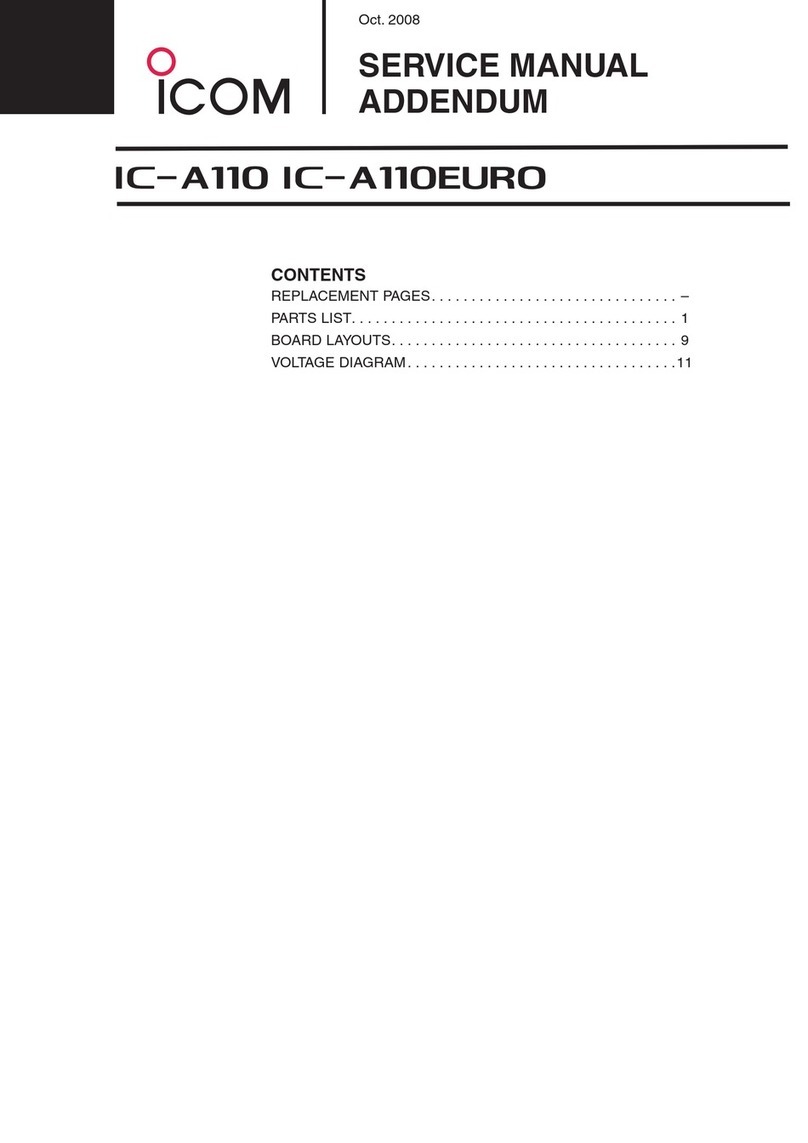
Icom
Icom IC-A110EURO Installation and operating instructions

Icom
Icom IC-PCR1500 User manual
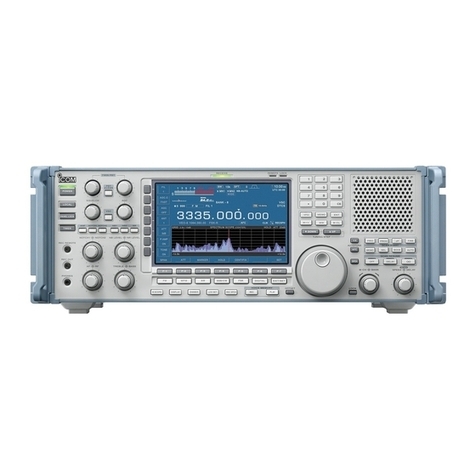
Icom
Icom IC-R9500 Installation and operating instructions
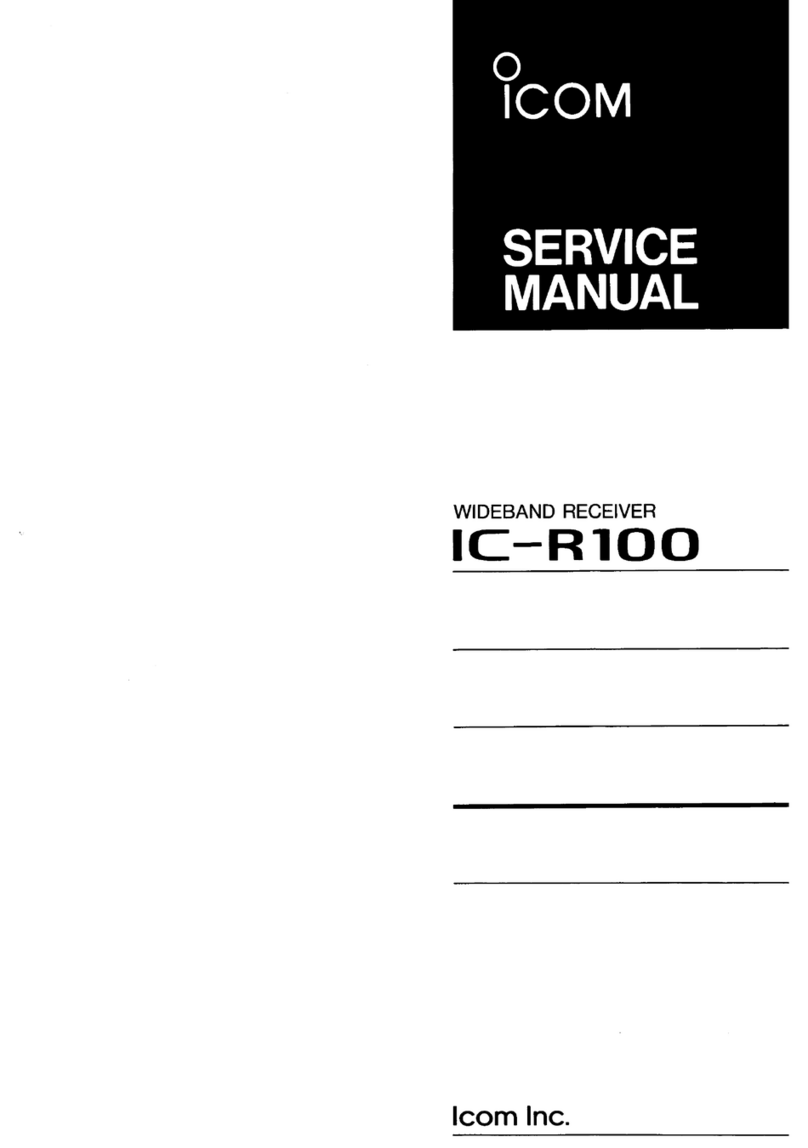
Icom
Icom IC-R100 User manual
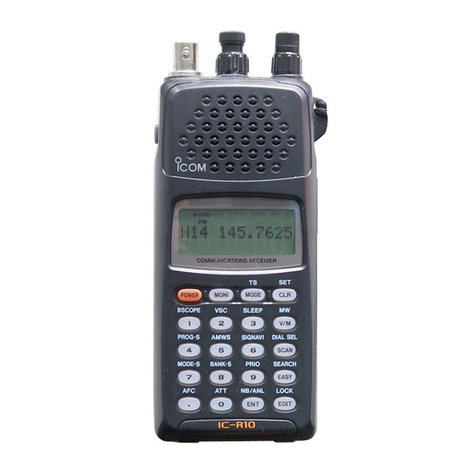
Icom
Icom IC-R10 User manual
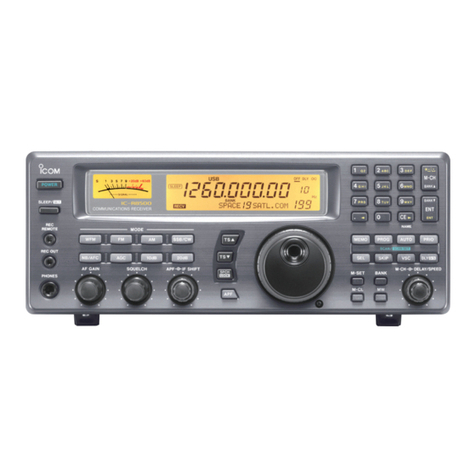
Icom
Icom iC- r8500 User manual

Icom
Icom IC-R7000 User manual
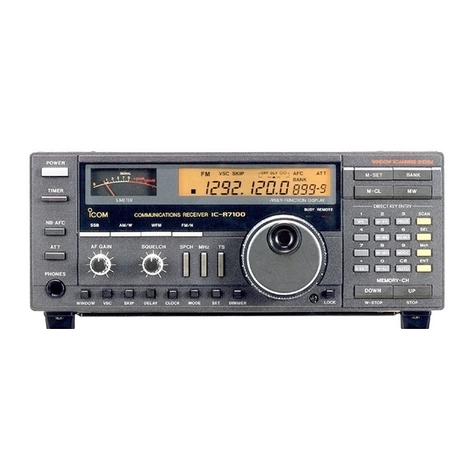
Icom
Icom IC-R7100 User manual
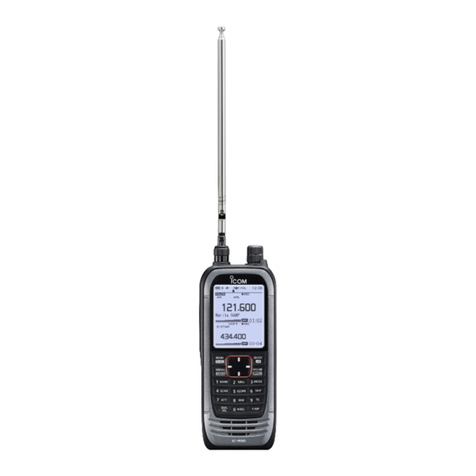
Icom
Icom IC-R30 Installation guide
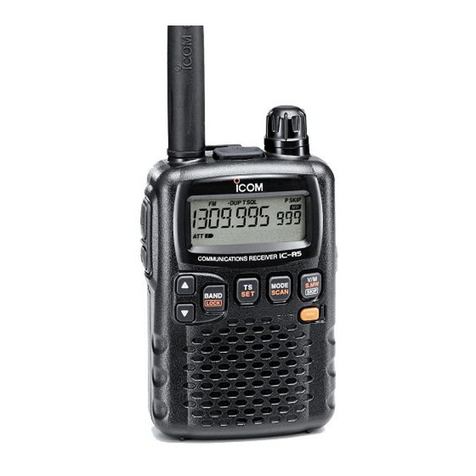
Icom
Icom IC-R5 User manual
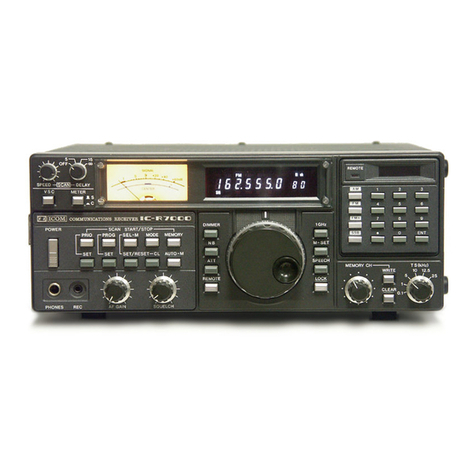
Icom
Icom IC-R7000 User manual

Icom
Icom IC-PCR1500 User manual
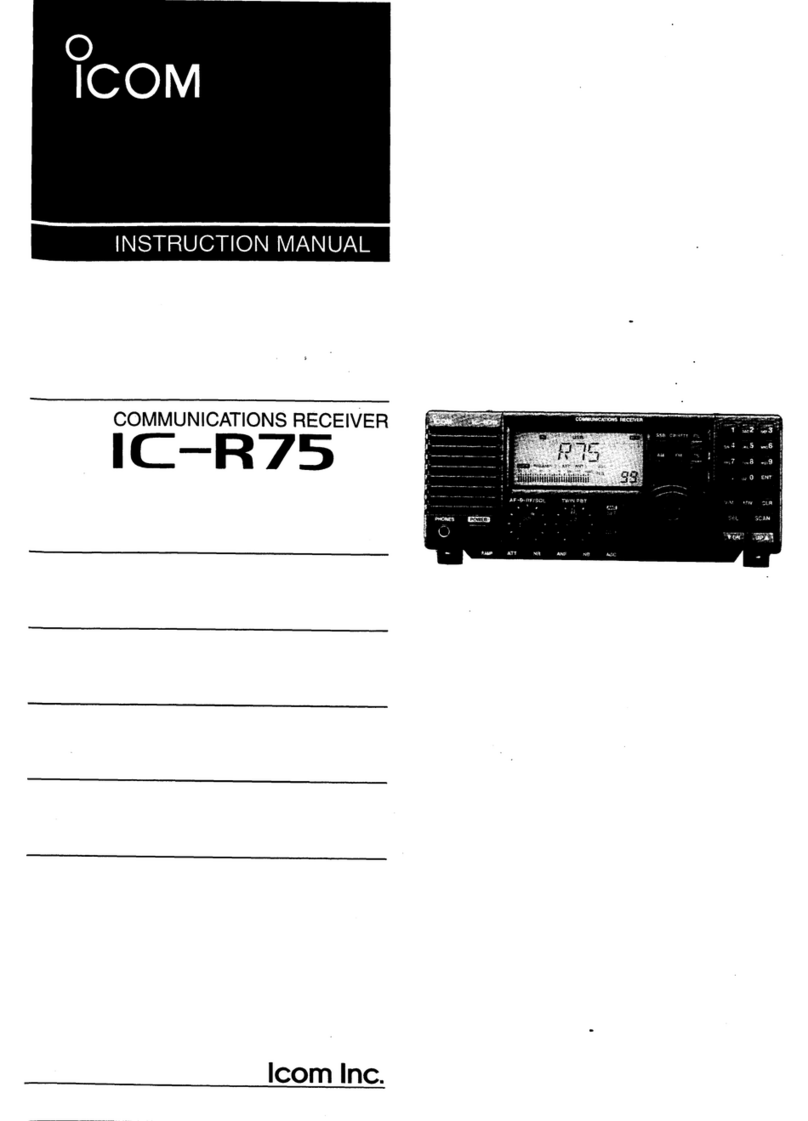
Icom
Icom IC-R75 User manual
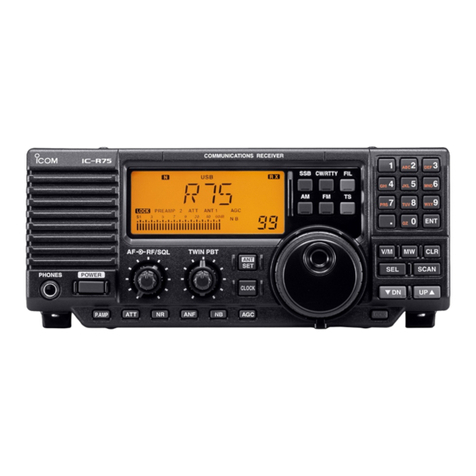
Icom
Icom IC-R75 User manual
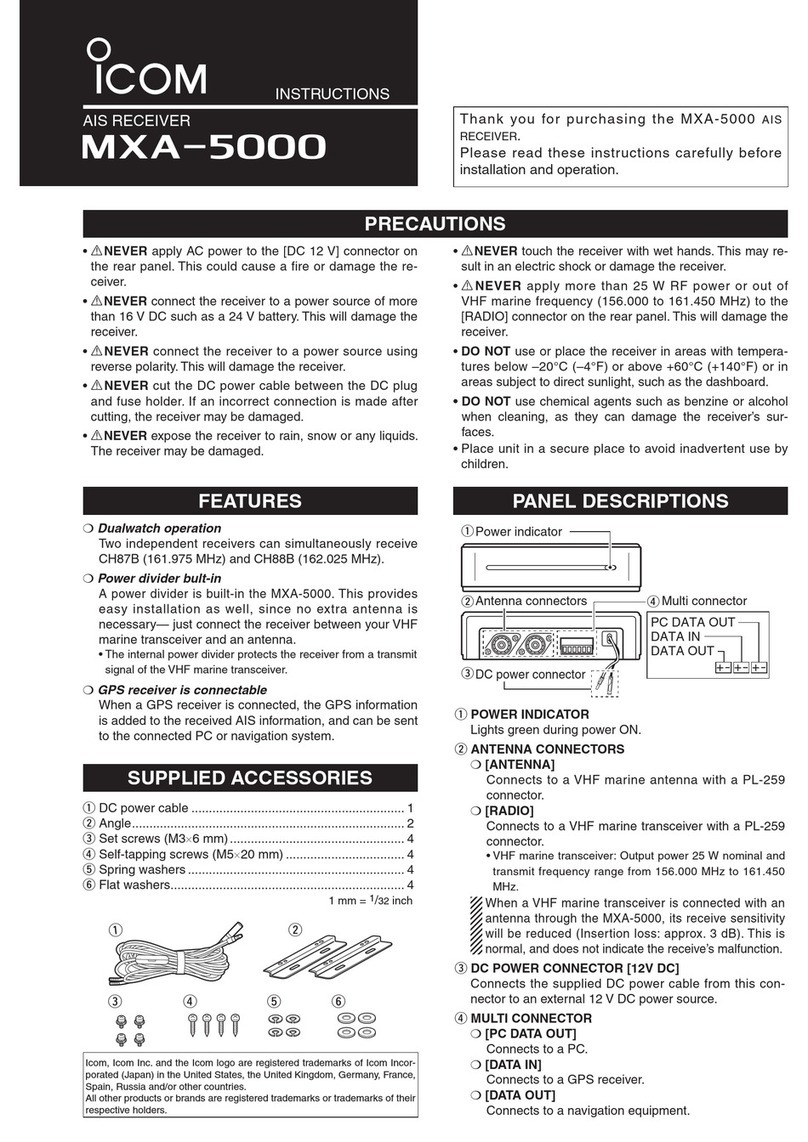
Icom
Icom MXA-5000 User manual
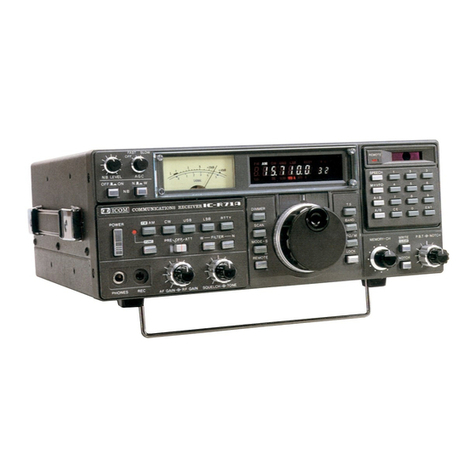
Icom
Icom IC-R71A User manual
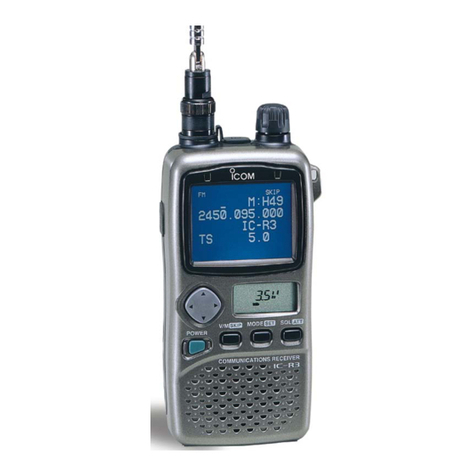
Icom
Icom COMMUNICATIONS RECEIVER IC-R3 User manual
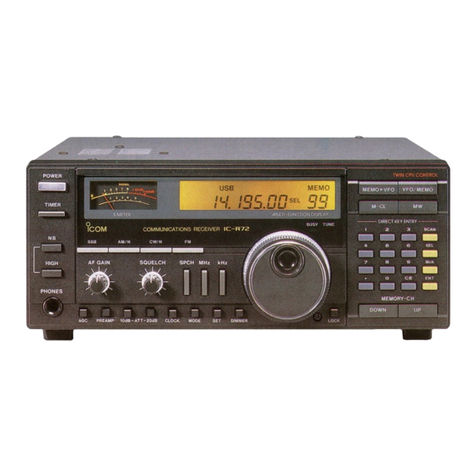
Icom
Icom IC-R72 User manual
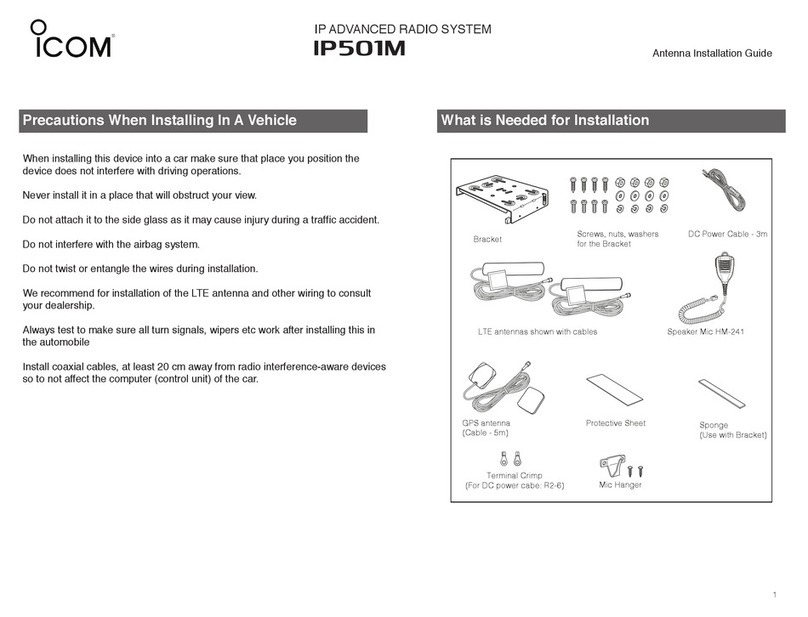
Icom
Icom IP501M User manual

Icom
Icom iC- r8500 User manual

